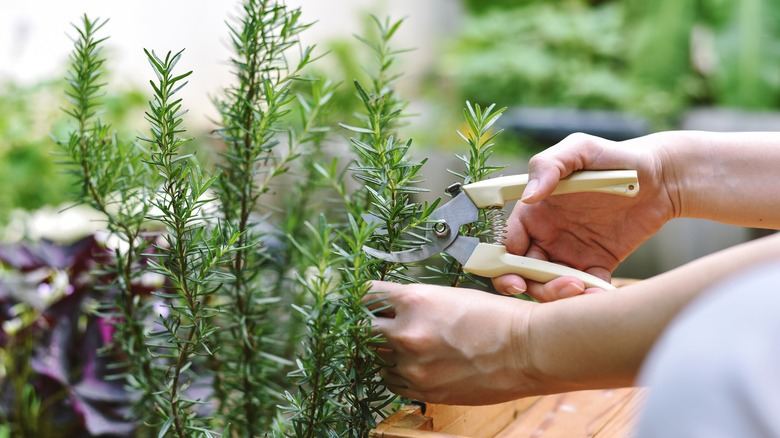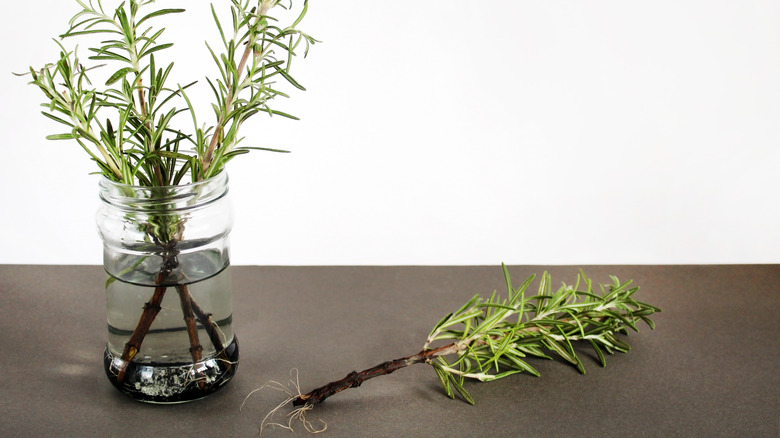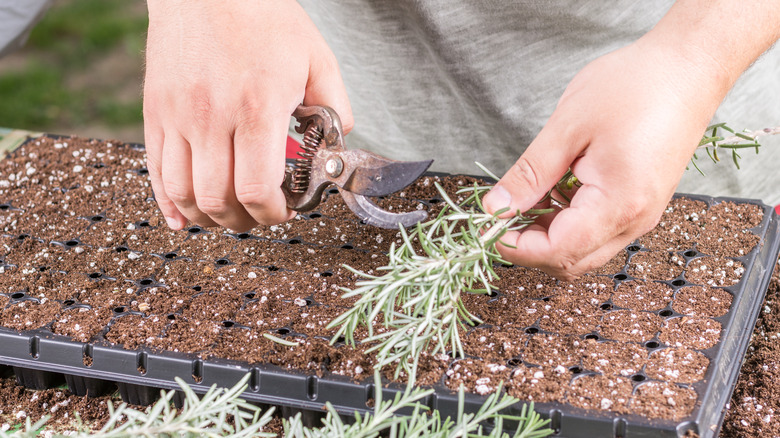Try These Easy Tips For Propagating Delicious Rosemary Indoors
We may receive a commission on purchases made from links.
Rosemary, a flavorful perennial favorite in herb gardens, is native to Europe's Mediterranean region. It thrives in plenty of sun, mild temperatures, and loamy but slightly sandy soil. Like other Mediterranean herbs, rosemary grows very well in containers, though in colder zones, it's best to move the plant pots inside during winter. Propagating rosemary from cuttings is a straightforward process that can be done in a few different ways.
Though it prefers a temperate growing zone, rosemary is a very sturdy plant that can live for many years in a container. Propagating it from cuttings is a great way to grow your own rosemary plants in containers or your garden beds. To begin propagating, first, you need some cuttings. Cuttings to propagate should be taken from the tender green stems of the rosemary plant instead of mature woody stems. The younger stems will produce root growth faster. It is possible to propagate rosemary using woody stem cuttings, but it will take longer and may not be as successful.
You don't need very long cuttings; 3 or 4 inches is enough. If possible, the cuttings should be taken below a leaf node on the stem and at a 45-degree angle, which allows for maximum uptake of water and nutrients to help stimulate growth. If you can't start to propagate right away, keep the cuttings loosely wrapped in a barely moistened paper towel. In the meantime, we'll go over the next steps so you can multiply your rosemary totally for free.
Propagate rosemary cuttings in water
Rosemary propagates very well from cuttings placed in water. This method allows for strong root systems to become established prior to planting in a container or your garden. Before placing in water, you must strip the leaves from the stem at the base of the cutting. The leaves should not be immersed in the water as this may interfere with root formation.
Once you strip the leaves, simply place the cut end of the rosemary stem into a clean glass of water. If using tap water, allow it to sit out for an hour before using it for chlorine and other chemicals to dissipate. Change out the water every few days or as it gets cloudy. Be patient, as it takes a bit of time for the roots to show. Within three to four weeks, you should see long white roots forming on the base of the cutting. Then, the cutting can be planted in a container with a potting medium.
Although rosemary can be propagated successfully in water, it's not a good idea to try and grow it in water for the long term. Because it does well forming roots in water, there is a misguided belief that rosemary can and should be grown hydroponically (without soil). However, a mature rosemary plant's woody stem and roots would be vulnerable to rot if left in water, so planting in soil is the best way to allow your rosemary plant to grow and thrive.
Rooting rosemary cuttings in soil
You can also propagate rosemary cuttings by placing them directly into the soil. However, first, you must treat the cut end with a substance that will stimulate root growth. Many people use standard rooting hormone powder to propagate cuttings. As with using water, prepare the cutting by stripping the leaves from the base of the stem. Leave an inch of leafless stem to go below the soil surface. Use a fresh, lightweight potting mix, and add a bit of sand if desired.
Dip the end of the rosemary cutting in rooting hormone powder, or try using powdered cinnamon as rooting hormone powder instead. Place the stem carefully into the soil-filled container (or planting tray if you're propagating multiple cuttings). You can also add some plant starter (Pennington offers theirs on Amazon for about $10), but this is optional and may not be necessary. Place your pots or tray in bright but indirect sunlight. Water lightly using a spray mister daily to keep the soil moist but not wet. After two to three weeks, tug lightly on the cutting to see if roots have started to form.
You can also use honey instead of rooting hormone powder. Yes, honey! Unpasteurized honey is best. Use this kitchen staple to root your cuttings the same way you would with the powder. Let the excess honey drip off before planting the stem. This method also takes about two to three weeks for roots to begin forming.



